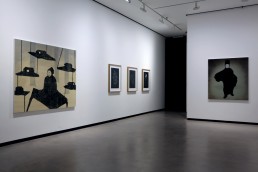Galleria Heino | Helsinki | 2017
18.11. – 17.12.2017
Sensory perceptions
Mixed media paintings, rendered on MDF using woodcut prints on washi paper, are perhaps the best-known feature of Antti Tanttu´s artistic output. In fact, Tanttu´s work also encompasses prints, watercolours, photography and video. In recent years, his palette has been characterised by restraint, featuring blacks and whites complemented by a series of muted shades.
The descriptions of the technique of the works and the reflection of light from a coloured object to the retina of the eye will never fully reveal to us how we experience Tanttu´s works, what sort of issues they address and the sort of emotional responses they evoke. Tanttu´s latest video work, Qualia, explores the individual nature of our perceptions and experiences. The title refers to both appearance and feel; what does the colour red look like? How does loneliness feel?
It has been argued that qualia are subjective experience, that each individual experience the colour red, for example, in a unique way, from personal perspective. And yet, more often than we think, the individual experience turns out to be a collective one. We generate meaning through comparison. Throughout history, artists, by ”laying their hearts bare” in their work, have actually revealed to us more about ourselves than themselves. As Madman´s Swing suggests, the artist is engaged in a balancing act behind strange doors to shed light into the darkness of everyday life.
Qualia contains references to Tanttu´s previous works. We see a traveller on stilts, tentatively making his way, a tree bearing strange fruit and a boat festooned with a will-o´-the-wisp. The familiar imagery links the new work with Tanttu´s creative continuum, but also anchors it in a broader frame of reference. References to literature, movies and music are part of the contextual web that Tanttu weaves. However, that context never gives set answers. His titles, such as Arctic Melancholy or The Elephant Man trigger a series of cultural associations without closing off meaning. For those (collectively) in the know, they propose one possible starting point to a personally meaningful analysis. However, the pleasure the works can give is never dependent on a prior knowledge of Marko Tapio´s novels or Joseph Merrick´s life story.
The problematic role of the individual within a community emerges time and again in Tanttu´s works. They act as a mirror, reflecting our society´s traumas and shortcomings but never assuming a hectoring, lecturing tone. Although often imbued with humour, his titles never shirk from asking awkward questions. Can the Meteorologist´s research findings be harnessed in our society´s ongoing pursuit of profit and productivity or is he just a cloud-monger? What about the Whisperer with his sad eyes, are we capable of pausing to hear what he has to say?
Loneliness has always been one of Tanttu´s most central themes. In his works, he has chosen to depict both the luxury of self-chosen solitude and the helplessness of involuntary isolation; the vulnerable are made visible and even the outcasts and the outlaws are included. In fact, many of Tanttu´s figures are reminiscent of the poor, and rather sweet, little devils created by Hugo Simberg. Tanttu´s souls are shown adrift and shivering in a world full of strangers. They search for their place in the world and seek connection with others. Their fumbling not just looks, but feels familiar.
Tomi Moisio, art historian
Thanks: Arts Promotion Centre Finland, City of Espoo





